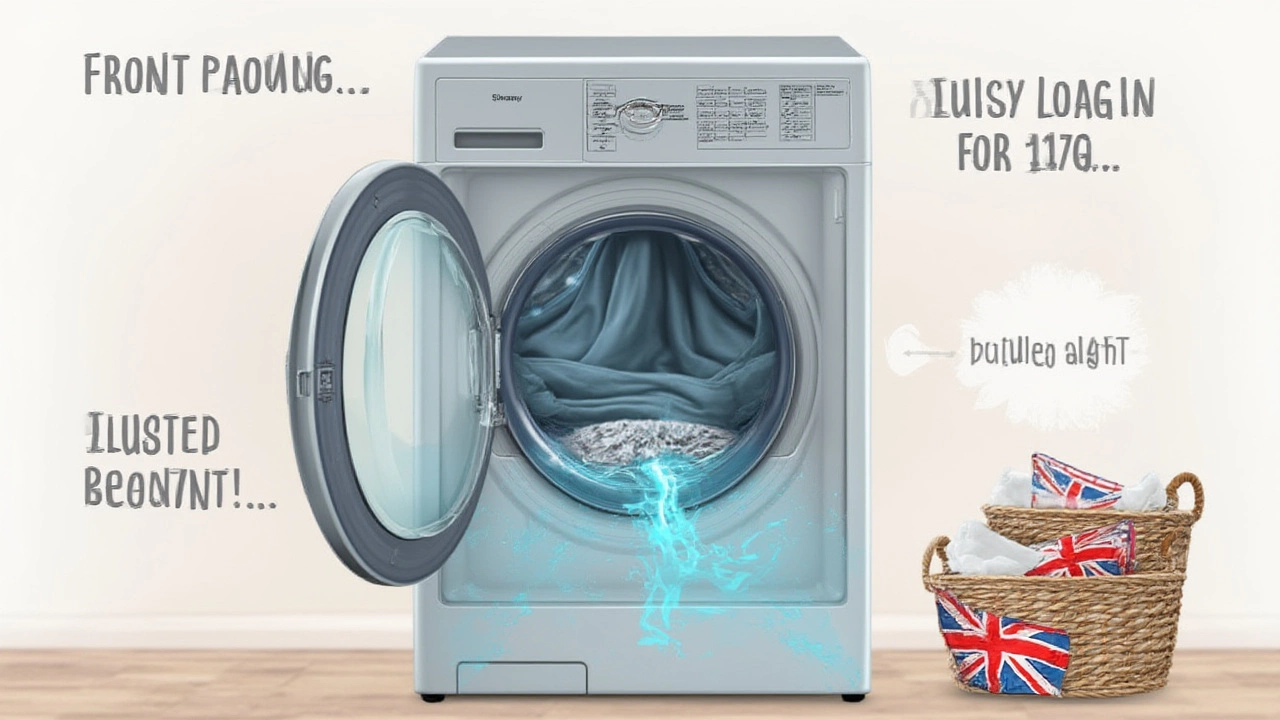Ever jump into your laundry day routine only to hear your washing machine thump, click, or just sit there, staring back at you in silent mutiny? You're not alone. If I could collect a dollar for every time someone complained, "My washer just won't spin!"—I'd be sitting on a beach somewhere, sipping something cold. The spin cycle failure is the kingpin of washing machine breakdowns.
Why the Spin Cycle Fails
If you've owned a washer for a while, you probably fear the moment you open the lid and find your clothes soaked, cold, and untouched by the magic of spinning. You're dealing with the most washing machine failures—the infamous spin cycle problem. Let's break down why this happens, in plain English.
It usually starts with the basics—your washer is loaded and ready, you hit start, but as it moves through its cycle, the spinning part just doesn’t kick in. What’s going on inside? Most often, you’re looking at a faulty lid switch, broken drive belt, worn-out motor coupler, or blocked drain pump. Believe it or not, the lid switch—a tiny, cheap safety feature that tells the washer the lid is closed—is the single most blamed part. If it’s busted, the washer thinks the lid is open and won’t spin. Next up, the drive belt. Like the chain on your bike, the drive belt connects the motor to the drum. With years of use (or just bad luck), it stretches, frays, or snaps. No belt, no spin. The motor coupler? It’s a little plastic and rubber joint linking the motor to the transmission. Overloading your machine or just old age makes it crack. And the drain pump—just a tiny sock or handful of coins can block it, so the washer won’t spin because it can’t drain water.
If you love data, here’s a look at typical causes, according to appliance repair pros:
| Cause | Frequency (%) |
|---|---|
| Broken Lid Switch | 34 |
| Faulty Drive Belt | 22 |
| Drain Pump Blockage | 19 |
| Motor Coupler Failure | 13 |
| Other Issues | 12 |
An interesting bit—according to a 2023 RepairNetwork survey, the "won’t spin" complaint accounted for a whopping 31% of all washer service calls in the UK.
Techs have a saying: "If it’s not spinning, start simple and check the switch." Many customers hear the click of the lid switch and assume all is well. But sometimes, the plastic arm inside the switch can break without any outward signs. The DIY fix is just to unplug your machine, find the switch under the lid (most top-loaders), and test it with a continuity tester, which you can pick up for a few quid.
It’s wild how often a belt is the culprit in machines 10 years or older. Belts should be tight, but with just a bit of give—about half an inch. Too loose? Replace it. These repairs sound daunting, but you can do a lot without ever calling a repairman, saving both time and your hard-earned money.
Laundry tends to pile up right before a holiday or just when you need clean socks for work, making the spin cycle a real villain at the worst times. But knowing the spin cycle is the most common headache, you can arm yourself with the basics of troubleshooting, and maybe even rescue your weekend.

How to Spot a Failing Spin Cycle
Sometimes, your washing machine tries to tell you something’s wrong before it flat-out refuses to spin. The symptoms can be obvious, or sneaky. Here’s what you want to watch for so you don’t end up mopping your laundry room floor at midnight.
First sign: The washer completes a cycle, but your clothes are soaking wet. Second, you might notice the machine making a humming sound, or the motor runs but the drum doesn’t move. Unusual noises are the third red flag—listen for grinding, squealing, or a burnt-rubber smell. Sometimes, the spin cycle starts, but abruptly stops. All these are textbook signs of problems with spinning.
If you own a modern washer, you may get an error code. LG washers love throwing out ‘OE’ or ‘LE’, while Samsung models sometimes show ‘UR’ for ‘unbalanced load’. These codes point right to the source, though getting your hands on the service manual is sometimes necessary to decode them.
For front-load models, watch for water pooling at the bottom, or the door that won’t unlock because the machine can't drain. If the pump’s blocked, the washer gets stuck mid-cycle, making you think there’s a secret ninja sock party in your drain system. That’s because a sensor detects standing water, locks the door, and halts the spin—sometimes for safety, sometimes because it’s confused.
A neat trick: Open the back panel of your washer—if safe and unplugged—and take a flashlight to the drive belt. Look for cracks, shiny spots, or outright breaks. If the belt is damaged, you’ve just solved the puzzle. If you hear a clunk when lifting or lowering the washing drum (especially top loaders), you might be dealing with a broken suspension spring or a loose drum, which can also interrupt spinning.
Washing machines these days are not just water buckets with a motor—they're bundled with sensors, logic boards, and loads of parts that all need to “talk” to each other. But in lots of homes, it’s still the simple stuff—broken switches, fudged belts, blocked pumps—that bring things to a standstill.
Here's what you can do if you’re handy:
- Always unplug the washer before opening it up.
- Check the lid switch for visible damage, and test with a multimeter.
- Inspect the belt—replace if cracked, burnt, or too loose.
- Open the drain pump filter and look for coins, socks, or buttons.
- Balance the load; washers can refuse to spin if clothes are bunched up on one side.
Listen to the words of appliance repair legend Harry Tindale, who told GoodHomeMag:
"The spin cycle is the most delicate stage—if anything is off, from a blocked hose to a dodgy lid switch, the machine will simply refuse to spin. But nine out of ten times, the fix is straightforward if you’re willing to open it up and look."
When you know what to look for, you’ll avoid most of the stress. And remember—don’t overload the washer! That’s the root of a ton of failures, and I see it day after day.

Troubleshooting and Preventing the Biggest Washing Machine Failure
You may be thinking, “Great, but what if I get unlucky and nothing works?” Or, maybe you’re the plan-ahead type and just want to keep your washer humming. Time for a pragmatic toolkit—real tricks (and some surprising stats) to avoid and fix the most common washing machine issue.
Start with prevention. Manufacturers like Whirlpool recommend regular maintenance every six months. What’s that mean for you? Run an empty hot cycle with a washing machine cleaner, clear out the drain pump filter, check the hoses for leaks, and glance at the drive belt if you can. Write it in your phone calendar; future-you will thank you.
If you’re already facing the no-spin blues, start with diagnostics:
- First, listen for unusual noises during the spin cycle—a healthy washer should be more of a gentle whoosh than a rattling bang.
- Next, try shifting the load to see if the drum will spin again—especially important for machines with sensors that detect uneven loads.
- Look for standing water after a cycle. If present, unclog the drain pump or hose (most washers have an accessible filter behind a small panel).
- Check for visible signs of wear on belts and couplers—sometimes you’ll spot rubber shavings, a dead giveaway for a failing drive belt.
- If your model has a diagnostic mode (many do!), run that and see what error code pops up. Popular brands have code lists online, so grab your phone and look them up.
Now, a few real-world tips repair pros swear by:
- Always use the right detergent—too many suds trick sensors, disabling the spin.
- Don’t overload or underload your washer—both extremes mess with balance sensors and can burn out the motor coupler or belt faster.
- Tighten the legs: Unbalanced machines jump and vibrate, pulling apart sensitive parts.
- Keep the machine’s filter and pump area free of debris. Coins, hairpins, and even bits of bra wire are notorious for sneaking in.
- If you're storing the washer for months, disconnect the water and power, drain completely, and prop open the lid or door to stop mould and musty smells—which can also affect spin sensors.
Did you know the average washing machine repair sets homeowners back £95-£160 in the UK? (According to Which? consumer group, 2024.) Sometimes, a quick part swap at home with a £10 lid switch or a £12 drive belt can save the day.
There’s a reason appliance pros always say: "Listen, 90% of washing machines can get another year or two of life if you catch problems early and don’t ignore weird noises."
Treat your washer with respect, act fast at the first sign of trouble, and odds are, you won’t find yourself hauling wet socks to the launderette anytime soon.







